battery CHEVROLET CAMARO 1967 1.G Chassis Repair Manual
[x] Cancel search | Manufacturer: CHEVROLET, Model Year: 1967, Model line: CAMARO, Model: CHEVROLET CAMARO 1967 1.GPages: 659, PDF Size: 114.24 MB
Page 343 of 659
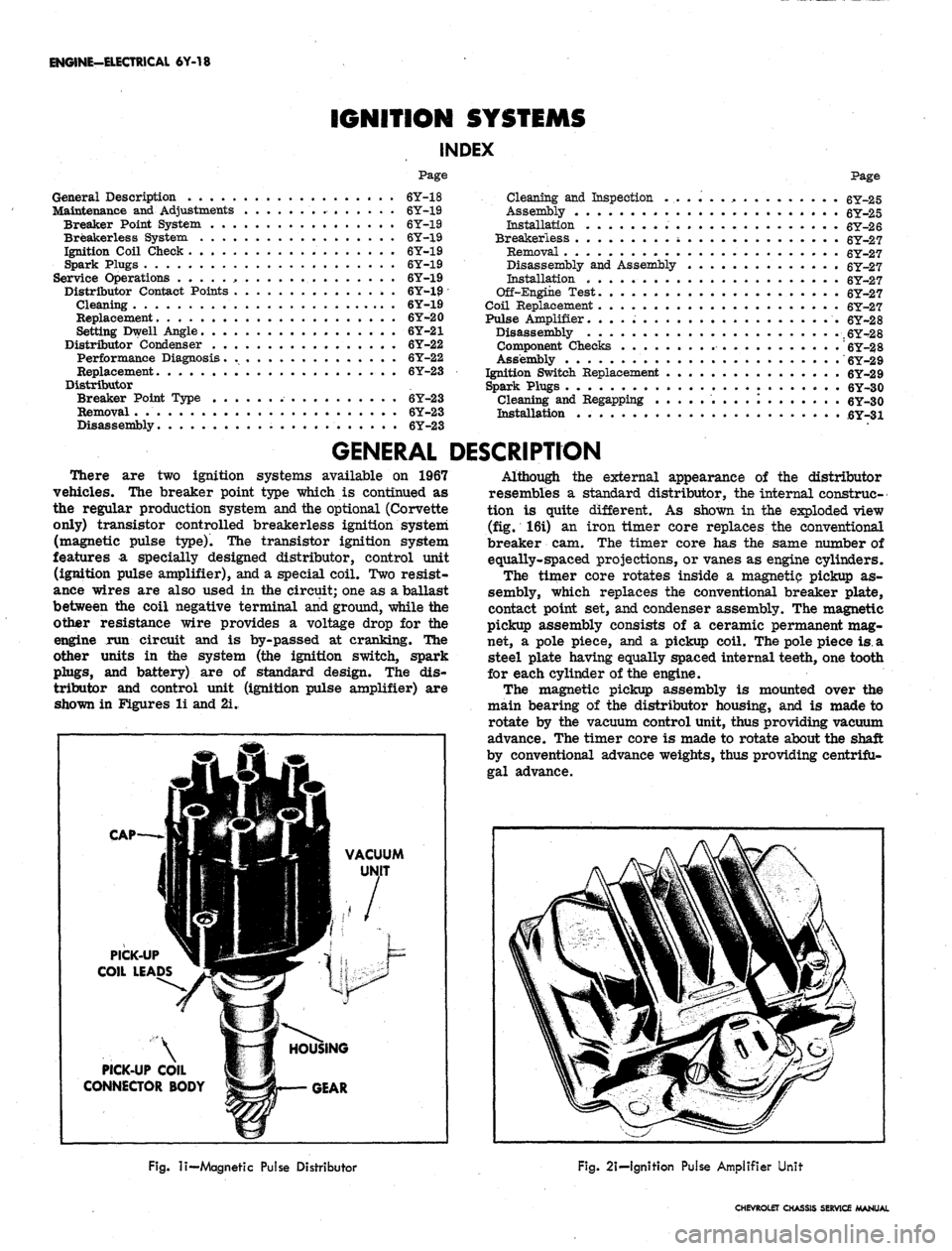
ENGINE-ELECTRICAL 6Y-18
IGNITION SYSTEMS
INDEX
Page
General Description . 6Y-18
Maintenance and Adjustments 6Y-19
Breaker Point System 6Y-19
Breakerless System . . 6Y-X9
Ignition Coil Check 6Y-19
Spark Plugs 6Y-19
Service Operations , 6Y-19
Distributor Contact Points . 6Y-19
Cleaning 6Y-19
Replacement 6Y-20
Setting Dwell Angle 6Y-21
Distributor Condenser 6Y-22
Performance Diagnosis. 6Y-22
Replacement . . 6Y-23
Distributor
Breaker Point Type 6Y-23
Removal. . 6Y-23
Disassembly • 6Y-23
Page
Cleaning and Inspection .....'.., 6Y-25
Assembly . 6Y-25
Installation 6Y-26
Breakerless i 6Y-27
Removal . 6Y-27
Disassembly and Assembly 6Y-27
Installation 6Y-27
Off-Engine Test. . 6Y-27
Coil Replacement 6Y-27
Pulse Amplifier. 6Y-28
Disassembly .6Y-4S8
Component Checks
!
6Y-28
Assembly 6Y-29
Ignition Switch Replacement 6Y-29
Spark Plugs 6Y-30
Cleaning and Regapping I ....... 6Y-30
Installation . 6Y-31
GENERAL DESCRIPTION
There are two ignition systems available on 1967
vehicles. The breaker point type which is continued as
the regular production system and the optional (Corvette
only) transistor controlled breakerless ignition system
(magnetic pulse type). The transistor ignition system
features a specially designed distributor, control unit
(ignition pulse amplifier), and a special coil. Two resist-
ance wires are also used in the circuit; one as a ballast
between the coil negative terminal and ground, while the
other resistance wire provides a voltage drop for the
engine run circuit and is by-passed at cranking. The
other units in the system (the ignition switch, spark
plugs,
and battery) are of standard design. The dis-
tributor and control unit (ignition pulse amplifier) are
shown in Figures li and 2i.
CAP-
VACUUM
PICK-UP
COIL LEADS
PICK-UP COIL
CONNECTOR BODY
Although the external appearance of the distributor
resembles a standard distributor, the internal construc-
tion is quite different. As shown in the exploded view
(fig. 16i) an iron timer core replaces the conventional
breaker cam. The timer core has the same number of
equally-spaced projections, or vanes as engine cylinders.
The timer core rotates inside a magnetic pickup as-
sembly, which replaces the conventional breaker plate,
contact point set, and condenser assembly. The magnetic
pickup assembly consists of a ceramic permanent mag-
net, a pole piece, and a pickup coil. The pole piece
is.
a
steel plate having equally spaced internal teeth, one tooth
for each cylinder of the engine.
The magnetic pickup assembly is mounted over the
main bearing of the distributor housing, and is made to
rotate by the vacuum control unit, thus providing vacuum
advance. The timer core is made to rotate about the shaft
by conventional advance weights, thus providing centrifu-
gal advance.
Fig.
li—
Magnetic Pulse Distributor
Fig.
2i-lgnition Pulse Amplifier Unit
CHEVROLET CHASSIS SERVICE MANUAL
Page 344 of 659
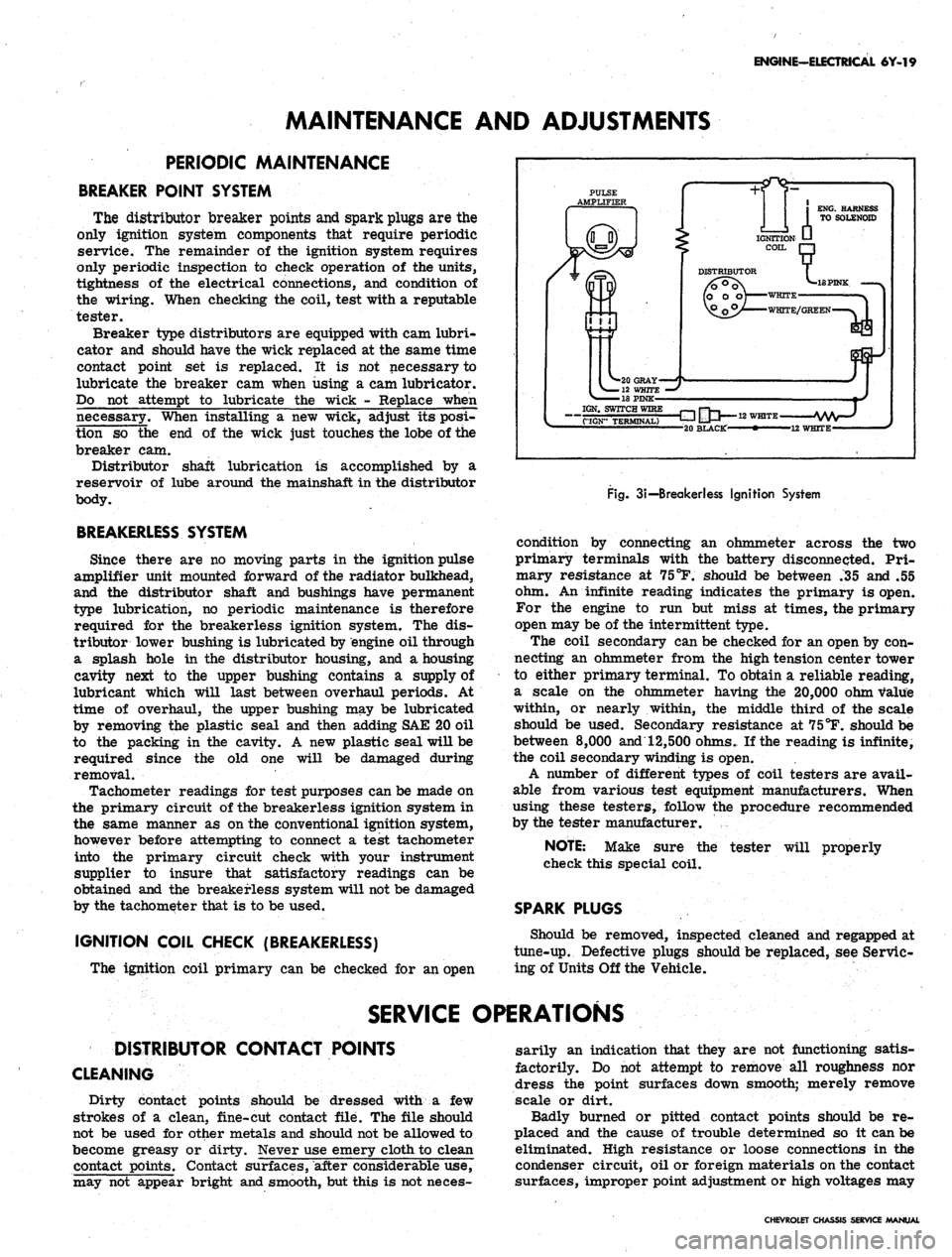
MAINTENANCE AND ADJUSTMENTS
ENGINE-ELECTRICAL 6Y-19
PERIODIC MAINTENANCE
BREAKER POINT SYSTEM
The distributor breaker points and spark plugs are the
only ignition system components that require periodic
service. The remainder of the ignition system requires
only periodic inspection to check operation of the units,
tightness of the electrical connections, and condition of
the wiring. When checking the coil, test with a reputable
tester.
Breaker type distributors are equipped with cam lubri-
cator and should have the wick replaced at the same time
contact point set is replaced. It is not necessary to
lubricate the breaker cam when using a cam lubricator.
Do not attempt to lubricate the wick - Replace when
necessary. When installing a new wick, adjust its posi-
tion so the end of the wick just touches the lobe of the
breaker cam.
Distributor shaft lubrication is accomplished by a
reservoir of lube around the mainshaft in the distributor
body.
BREAKERLESS SYSTEM
Since there are no moving parts in the ignition pulse
amplifier unit mounted forward of the radiator bulkhead,
and the distributor shaft and bushings have permanent
type lubrication, no periodic maintenance is therefore
required for the breakerless ignition system. The dis-
tributor lower bushing is lubricated by engine oil through
a splash hole in the distributor housing, and a housing
cavity next to the upper bushing contains a supply of
lubricant which will last between overhaul periods. At
time of overhaul, the upper bushing may be lubricated
by removing the plastic seal and then adding SAE 20 oil
to the packing in the cavity. A new plastic seal will be
required since the old one will be damaged during
removal.
Tachometer readings for test purposes can be made on
the primary circuit of the breakerless ignition system in
the same manner as on the conventional ignition system,
however before attempting to connect a test tachometer
into the primary circuit check with your instrument
supplier to insure that satisfactory readings can be
obtained and the breakerless system will not be damaged
by the tachometer that is to be used,
IGNITION COIL CHECK (BREAKERLESS)
The ignition coil primary can be checked for an open
PULSE
AMPLIFIER
IGN. SWITCH WIRE
"("IGN" TERMINAL)
-E3 IJU
12
WHITE-
-20 BLACKf' • 12 WHITE-
Fig.
3i—
Breakerless Ignition System
condition by connecting an ohmmeter across the two
primary terminals with the battery disconnected. Pri-
mary resistance at 75
°F.
should be between .35 and .55
ohm. An infinite reading indicates the primary is open.
For the engine to run but miss at times, the primary
open may be of the intermittent type.
The coil secondary can be checked for an open by con-
necting an ohmmeter from the high tension center tower
to either primary terminal. To obtain a reliable reading,
a scale on the ohmmeter having the 20,000 ohm value
within, or nearly within, the middle third of the scale
should be used. Secondary resistance at 75°F. should be
between
8,000
and 12,500 ohms. If the reading is infinite,
the coil secondary winding is open.
A number of different types of coil testers are avail-
able from various test equipment manufacturers. When
using these testers, follow the procedure recommended
by the tester manufacturer.
tester will properly
NOTE:
Make sure the
check this special coil.
SPARK PLUGS
Should be removed, inspected cleaned and regapped at
tune-up. Defective plugs should be replaced, see Servic-
ing of Units Off the Vehicle.
SERVICE OPERATIONS
DISTRIBUTOR CONTACT POINTS
CLEANING
Dirty contact points should be dressed with a few
strokes of a clean, fine-cut contact file. The file should
not be used for other metals and should not be allowed to
become greasy or dirty. Never use emery cloth to clean
contact points. Contact surfaces, after considerable use,
may not appear bright and smooth, but this is not neces-
sarily an indication that they are not functioning satis-
factorily. Do not attempt to remove all roughness nor
dress the point surfaces down smooth; merely remove
scale or dirt.
Badly burned or pitted contact points should be re-
placed and the cause of trouble determined so it can be
eliminated. High resistance or loose connections in the
condenser circuit, oil or foreign materials on the contact
surfaces, improper point adjustment or high voltages may
CHEVROLET CHASSIS SERVICE MANUAL
Page 354 of 659
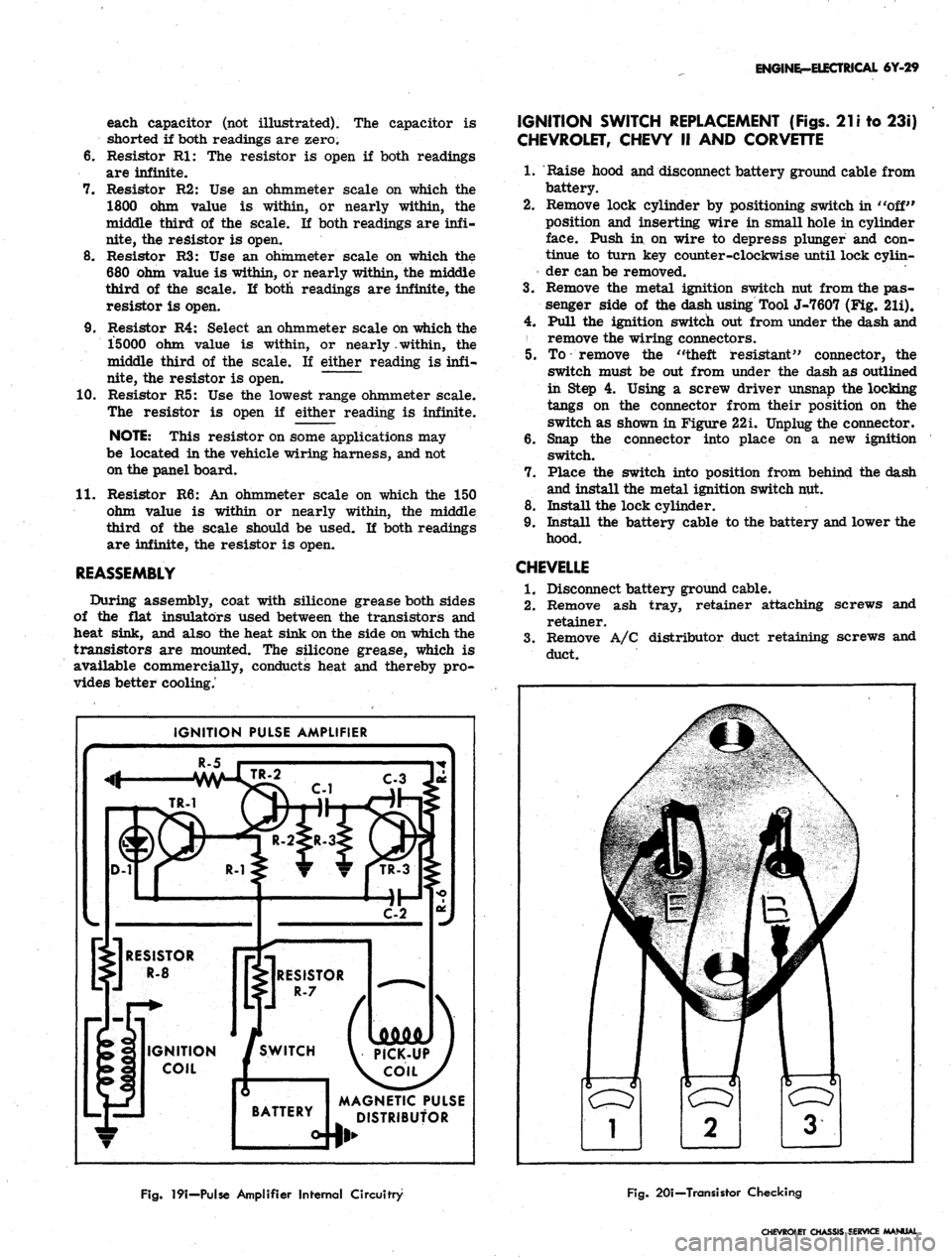
ENGINE-ELECTRICAL 6Y-29
each capacitor (not illustrated). The capacitor is
shorted if both readings are zero.
6. Resistor Rl: The resistor is open if both readings
are infinite.
7. Resistor R2: Use an ohmmeter scale on which the
1800 ohm value is within, or nearly within, the
middle third of the scale. If both readings are infi-
nite, the resistor is open.
8. Resistor R3: Use an ohmmeter scale on which the
680 Ohm value is within, or nearly within, the middle
third of the scale. If both readings are infinite, the
resistor is open.
9. Resistor R4: Select an ohmmeter scale on which the
15000 ohm value is within, or nearly .within, the
middle third of the scale. If either reading is infi-
nite, the resistor is open. ~
10.
Resistor R5: Use the lowest range ohmmeter scale.
The resistor is open if either reading is infinite.
NOTE:
This resistor on some applications may
be located in the vehicle wiring harness, and not
on the panel board.
11.
Resistor R6: An ohmmeter scale on which the 150
ohm value is within or nearly within, the middle
third of the scale should be used. If both readings
are infinite, the resistor is open.
REASSEMBLY
During assembly, coat with silicone grease both sides
of the flat insulators used between the transistors and
heat sink, and also the heat sink on the side on which the
transistors are mounted. The silicone grease, which is
available commercially, conducts heat and thereby pro-
vides better cooling.'
IGNITION PULSE AMPLIFIER
R-5
C-3 Ju
MAGNETIC PULSE
DISTRIBUTOR
IGNITION SWITCH REPLACEMENT (Figs.
21
i to 23i)
CHEVROLET, CHEVY II AND CORVETTE
1.
Raise hood and disconnect battery ground cable from
battery.
2.
Remove lock cylinder by positioning switch in "off"
position and inserting wire in small hole in cylinder
face. Push in on wire to depress plunger and con-
tinue to turn key counter-clockwise until lock cylin-
der can be removed.
3.
Remove the metal ignition switch nut from the pas-
senger side of the dash using Tool J-7607 (Fig. 21i).
4.
Pull the ignition switch out from under the dash and
remove the wiring connectors.
5. To remove the "theft resistant" connector, the
switch must be out from under the dash as outlined
in Step 4. Using a screw driver unsnap the locking
tangs on the connector from their position on the
switch as shown in Figure 22i. Unplug the connector.
6. Snap the connector into place on a new ignition
switch.
7. Place the switch into position from behind the dash
and install the metal ignition switch nut.
8. Install the lock cylinder.
9. Install the battery cable to the battery and lower the
hood.
CHEVELLE
1.
Disconnect battery ground cable.
2.
Remove ash tray, retainer attaching screws and
retainer.
3.
Remove A/C distributor duct retaining screws and
duct.
Fig.
19i—Pulse Amplifier Internal Circuitry
Fig.
20i—Transistor Checking
CHEVROLET Oi
Page 357 of 659

ENGINE-ELECTRICAL 6Y-32
STARTER CIRCUIT
INDEX
Page
General Description 6Y-32
Maintenance and Adjustments . '. . 6Y-32
Resistance Checks 6Y-32
Starting Motor and Solenoid Check 6Y-33
Page
Service Operations 6Y-33
Starter Motor 6Y-33
Removal and Installation 6Y-33
GENERAL DESCRIPTION
The function of the starting system, composed of the
starting motor, solenoid and battery, is to crank the
engine. The battery supplies the electrical energy, the
solenoid completes the circuit to the starting motor, and
the motor then does the actual work of cranking the
engine.
The starting motor (fig. Is) consists primarily of the
drive mechanism, frame, armature, brushes, and field
windings. The starting motor is a pad mounted 12-volt
extruded frame type, having four pole shoes and four
fields,
connected with the armature. The aluminum drive
end housing is extended to enclose the entire shift lever
and plunger mechanism, protecting them from dirt,
splash, and icing. The flange mounted solenoid switch
operates the overrunning clutch drive by means of a
linkage to the shaft lever.
The V-8 wiring harness differs from the in-line engine
in that the ignition lead to the coil from the switch is at-
tached at the coil instead of at the starter solenoid (fig.
2s).
CONTACT
FINGER
PINION
STOP
BRUSH
INSULATED BRUSH HOLDER \ FIELD COIL
BRUSH SPRING ARMATURE
GROUNDED BRUSH HOLDER
OVERRUNNING
CLUTCH
Fig.
Is—Starting Motor Cross Section (Typical)
MAINTENANCE AND ADJUSTMENTS
No periodic lubrication of the starting motor or sole-
noid is required. Since the starting motor and brushes
cannot be inspected without disassembling the unit, no.
service is required on these units between overhaul
periods.
RESISTANCE CHECKS
Although the starting motor cannot be checked against
specifications on the car, a check can be made for. exces-
sive resistance in the starting circuit. Place a volt-
meter across points in the cranking circuit as outlined
below and observe the reading with the starting switch
closed and the motor cranking (distributor primary lead
grounded to prevent engine firing).
1.
From battery positive post To solenoid battery
terminal.
CHEVROLET CHASSIS SERVICE MANUAL
Page 358 of 659
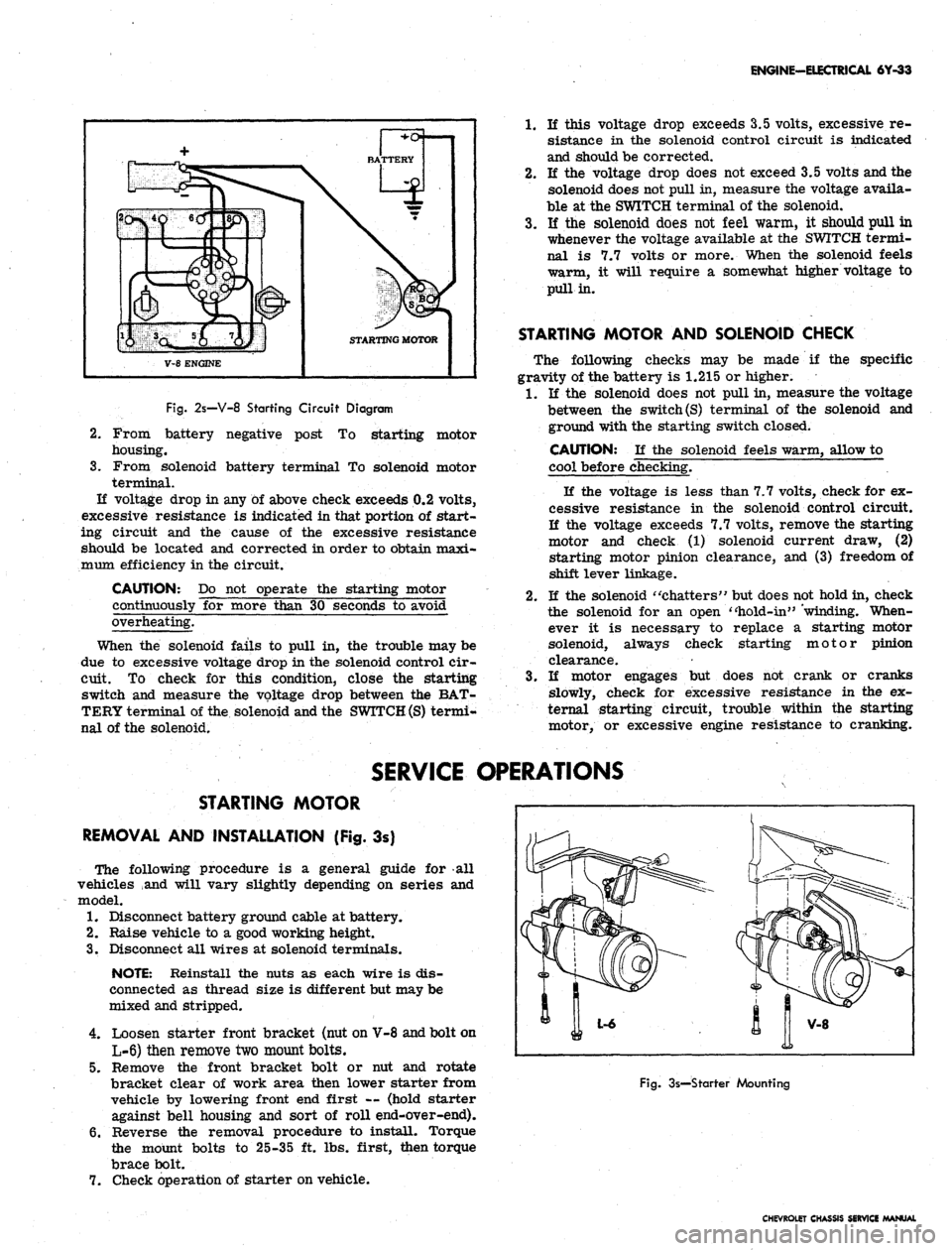
ENGINE-ELECTRICAL 6Y-33
O
V-8 ENGINE
STARTING MOTOR
Fig.
2s—V-8 Starting Circuit Diagram
2.
3.
From battery negative post
To
starting motor
housing.
From solenoid battery terminal
To
solenoid motor
terminal.
If voltage drop
in
any
of
above check exceeds 0.2 volts,
excessive resistance
is
indicated in that portion
of
start-
ing circuit
and the
cause
of the
excessive resistance
should
be
located
and
corrected
in
order to obtain maxi-
mum efficiency in the circuit.
CAUTION:
Do not
operate
the
starting motor
continuously
for
more than
30
seconds
to
avoid
overheating.
When
the
solenoid fails
to
pull
in, the
trouble may be
due
to
excessive voltage drop in the solenoid control cir-
cuit.
To
check
for
this condition, close
the
starting
switch
and
measure
the
voltage drop between
the
BAT-
TERY terminal of the solenoid and the
SWITCH (S)
termi-
nal
of
the solenoid.
1.
If
this voltage drop exceeds 3.5 volts, excessive
re-
sistance
in the
solenoid control circuit
is
indicated
and should be corrected.
2.
If the
voltage drop does not exceed 3.5 volts and the
solenoid does not pull in, measure the voltage availa-
ble
at
the SWITCH terminal
of
the solenoid.
3.
If the
solenoid does
not
feel warm,
it
should pull
in
whenever the voltage available
at
the SWITCH termi-
nal
is 7.7
volts
or
more. When
the
solenoid feels
warm,
it
will require
a
somewhat higher voltage
to
pull in.
STARTING MOTOR AND SOLENOID CHECK
The following checks
may be
made
if the
specific
gravity of the battery
is
1.215
or
higher.
1.
If the
solenoid does
not
pull in, measure the voltage
between
the
switch
(S)
terminal
of the
solenoid
and
ground with the starting switch closed.
CAUTION:
If the
solenoid feels warm, allow
to
cool before checking.
If
the
voltage
is
less than 7.7 volts, check for ex-
cessive resistance
in the
solenoid control circuit.
If
the
voltage exceeds 7.7 volts, remove the starting
motor
and
check
(1)
solenoid current draw,
(2)
starting motor pinion clearance,
and (3)
freedom of
shift lever linkage.
2.
If
the solenoid "chatters" but does not hold in, check
the solenoid
for an
open "hold-in" 'winding. When-
ever
it is
necessary
to
replace
a
starting motor
solenoid, always check starting motor pinion
clearance.
3.
If
motor engages
but
does
not
crank
or
cranks
slowly, check
for
excessive resistance
in the ex-
ternal starting circuit, trouble within
the
starting
motor,
or
excessive engine resistance
to
cranking.
SERVICE OPERATIONS
STARTING MOTOR
REMOVAL AND INSTALLATION (Fig.
3s)
The following procedure
is a
general guide
for all
vehicles
and
will vary slightly depending
on
series
and
model.
1.
Disconnect battery ground cable at battery.
2.
Raise vehicle
to a
good working height.
3.
Disconnect all wires
at
solenoid terminals.
NOTE: Reinstall
the
nuts
as
each wire
is
dis-
connected
as
thread size
is
different but may be
mixed and stripped.
4.
Loosen starter front bracket (nut on V-8 and bolt on
L-6) then remove two mount bolts.
5.
Remove
the
front bracket bolt
or nut and
rotate
bracket clear
of
work area then lower starter from
vehicle
by
lowering front end first
—
(hold starter
against bell housing
and
sort
of
roll end-over-end).
6. Reverse
the
removal procedure
to
install. Torque
the mount bolts
to
25-35
ft.
lbs. first, then torque
brace bolt.
7.
Check operation
of
starter on vehicle.
Fig.
3s—Starter Mounting
CHEVROLET CHASSIS SERVICE MANUAL
Page 368 of 659

CLUTCH AND TRANSMISSIONS 7-9
6. Connect speedometer cable.
7. Install propeller shaft assembly.
8. Fill transmission with lubricant specified in Section
O.
CORVETTE TRANSMISSION REPLACEMENT
, 1. Disconnect battery ground cable.
2.
Pisassemble transmission shift control lever by un-
screwing ball from lever, lifting out
"T"
handle re-
turn spring and "T" handle, then remove the anti-
rattle bushings.
3.
Raise front and rear of vehicle.
4.
Insert a block of wood between the top of the dif-
ferential carrier housing and the underbody (to pre-
vent upward travel of the carrier when the carrier
front support is disconnected).
5. Disconnect the differential carrier front supportfrom
its frame bracket, by removing the nut on the under-
side of the biscuit mount.
6. Pry the carrier downward to relieve load while re-
moving the two center mounting bolts from the car-
rier front support. (To pry carrier downward insert
crowfoot end of a pry bar through the opening in the
carrier front support, hooking end of bar over top of
the center mounting bolt pad cast in the underside of
the carrier.)
7. Pivot carrier support downward for access to prop
shaft "U" joint.
8.
.
Disconnect prop shaft front and then rear "U" bolts.
9. Disconnect parking brake cable from ball socket at
idler lever located near center of underbody.
10.
Remove prop shaft by moving shaft forward.
11.
Remove heat deflectors from the right and left ex-
haust pipe.
12.
Remove left bank exhaust pipe.
13.
Remove right bank exhaust pipe and heat riser.
14.
Disassemble the transmission mount, as follows:
a. Remove the two bolts that attach rear mount
cushion to the rear mount bracket.
b.
Support engine under oil pan and raise engine to
remove load from rear mount cushion.
CAUTION: To avoid damage to oil pan, a suit-
able wide base, heavy wood platform should be
placed between the jack pad and the oil pan.
c. Remove the three transmission mount bracket-
to-
crossm ember bolts and remove mount bracket.
d. Remove the two bolts from mount pad to trans-
mission case and remove rubber mount cushion
and exhaust pipe "yoke".
15.
Disconnect transmission linkage by removing the
shift levers at the transmission side cover.
16.
Disconnect speedo cable at transmission extension.
17.
Remove transmission output shaft slip yoke.
NOTE:
The yoke is removed to avoid tearing
the heat reflecting pad on the underbody, when
the transmission is being removed.
18.
Remove two bolts to disconnect the transmission
gearshift control lever and bracket assembly from
its adapter plate on side of transmission. Lower
transmission assembly from the vehicle, letting the
gearshift lever slide down and through the dust boot
in the console.
19.
Remove transmission-to-clutch housing attaching
bolts.
20.
Slide transmission assembly rearward from clutch
and rotate transmission for access to the three flat
head machine screws in the control lever bracket
adapter plate. Remove adapter plate. Rotate trans-
mission back to the upright position.
21.
To allow room for transmission removal slowly
lower the rear of engine until the tachometer drive
cable at the distributor just clears the horizontal
ledge across the front of dash.
CAUTION: The tachometer cable can be easily
damaged by heavy contact with the dash. Slide
transmission rearward out of the clutch, then
tip front end of transmission downward and
lower the assembly from vehicle.
22.
Reinstall transmission assembly by performing above
steps in reverse order.
TRANSMISSION OVERDRIVE
INDEX
Page
General
Description 7-10
Maintenance
and Adjustments 7—10
Governor
Switch and Pinion .............. 7-10
Sun
Gear Solenoid Oil Seal and Control
Cable
Bracket 7-10
Case
Rear Oil Seal 7-10
Removal
7-10
Installation
. . . . . 7-10
Control
Shaft Lever and Oil Seal 7-10
Speedometer
Driven Gear 7-10
Electrical
Unit Checks 7-11
Overdrive
Relay . 7-11
Page
Air
Gap 7-11
Point
Opening 7-11
Closing
Voltage 7-11
Solenoid
. 7-11
Closing
Coil 7-11
Engaging
Spring . - 7-11
Ignition
Grounding Contact . 7-11
Governor
Switch 7-11
Kickdown
Switch 7-11
Diagnosis
- Overdrive 7-12
Mechanical
. 7-12
Electrical
7-13
CHEVROLET CHASSIS SERVICE MANUAL
Page 370 of 659
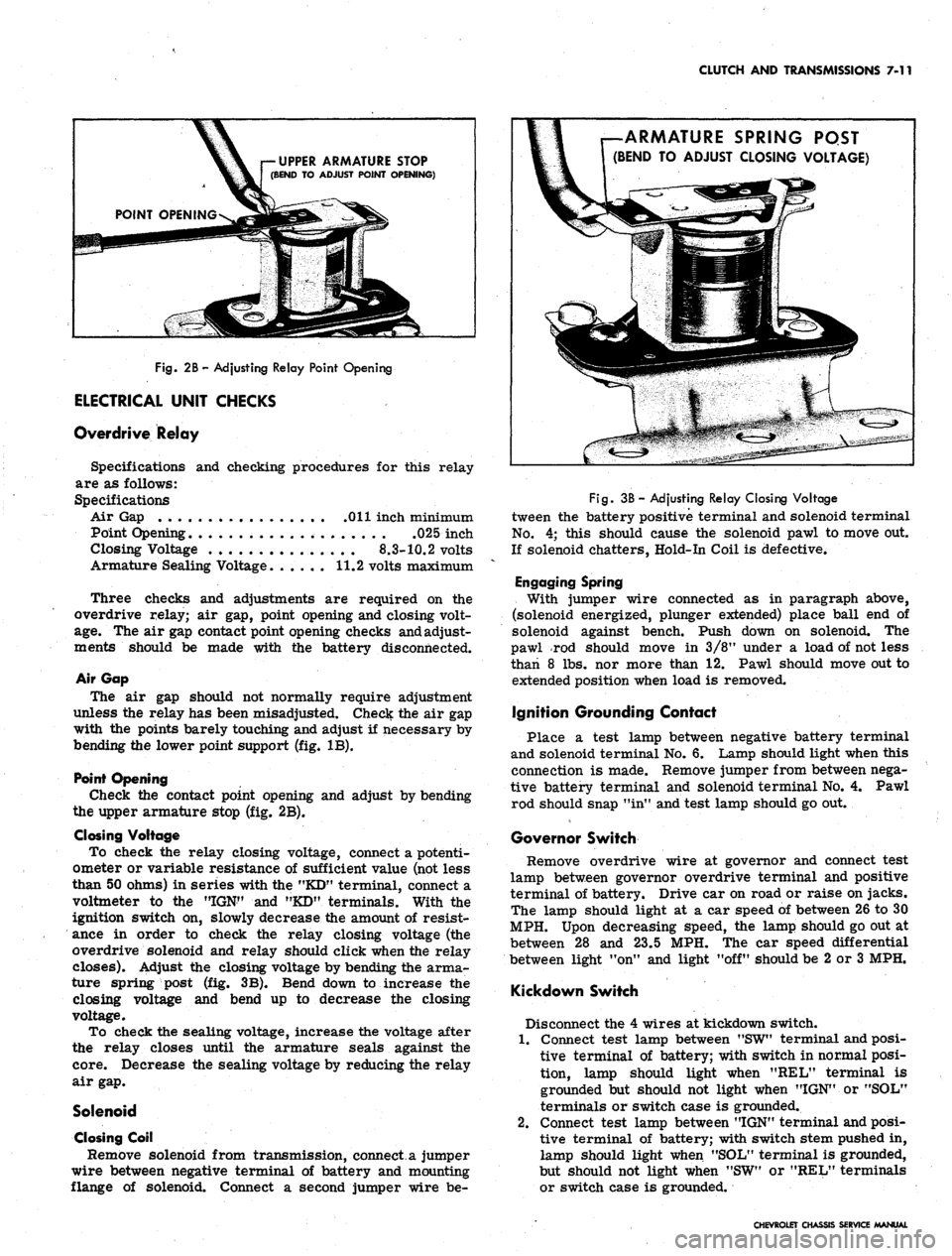
CLUTCH AND TRANSMISSIONS 7-11
UPPER ARMATURE STOP
(BEND TO ADJUST POINT OPENING)
Fig.
2B-Adjusting Relay Point Opening
ELECTRICAL UNIT CHECKS
Overdrive Relay
Specifications and checking procedures for this relay
are as follows:
Specifications
Air Gap Oil inch minimum
Point Opening .025 inch
Closing Voltage
8.3-10.2
volts
Armature Sealing Voltage. ..... 11.2 volts maximum
Three checks and adjustments are required on the
overdrive relay; air gap, point opening and closing volt-
age.
The air gap contact point opening checks and adjust-
ments should be made with the battery disconnected.
Air Gap
The air gap should not normally require adjustment
unless the relay has been misadjusted. Check the air gap
with the points barely touching and adjust if necessary by
bending the lower point support (fig, IB).
Point Opening
Check the contact point opening and adjust by bending
the upper armature stop (fig. 2B).
Closing Voltage
To check the relay closing voltage, connect a potenti-
ometer or variable resistance of sufficient value (not less
than 50 ohms) in series with the "KD" terminal, connect a
voltmeter to the "IGN" and "KD" terminals. With the
ignition switch on, slowly decrease the amount of resist-
ance in order to check the relay closing voltage (the
overdrive solenoid and relay should click when the relay
closes). Adjust the closing voltage by bending the arma-
ture spring post (fig. 3B). Bend down to increase the
closing voltage and bend up to decrease the closing
voltage.
To check the sealing voltage, increase the voltage after
the relay closes until the armature seals against the
core.
Decrease the sealing voltage by reducing the relay
air gap.
Solenoid
Closing Coil
Remove solenoid from transmission, connect a jumper
wire between negative terminal of battery and mounting
flange of solenoid. Connect a second jumper wire be-
ARMATURE SPRING PQST
(BEND TO ADJUST CLOSING VOLTAGE)
Fig.
3B - Adjusting Relay Closing Voltage
tween the battery positive terminal and solenoid terminal
No.
4; this should cause the solenoid pawl to move out.
If solenoid chatters, Hold-In Coil is defective.
Engaging Spring
With jumper wire connected as in paragraph above,
(solenoid energized, plunger extended) place ball end of
solenoid against bench. Push down on solenoid. The
pawl rod should move in 3/8M under a load of not less
than 8 lbs. nor more than 12. Pawl should move out to
extended position when load is removed.
Ignition Grounding Contact
Place a test lamp between negative battery terminal
and solenoid terminal No. 6. Lamp should light when this
connection is made. Remove jumper from between nega-
tive battery terminal and solenoid terminal No. 4. Pawl
rod should snap "in" and test lamp should go out.
Governor Switch
Remove overdrive wire at governor and connect test
lamp between governor overdrive terminal and positive
terminal of battery. Drive car on road or raise on jacks.
The lamp should light at a car speed of between 26 to 30
MPH. Upon decreasing speed, the lamp should go out at
between 28 and 23.5 MPH. The car speed differential
between light "on" and light "off" should be 2 or 3 MPH.
Kickdown Switch
Disconnect the 4 wires at kickdown switch.
1.
Connect test lamp between "SW" terminal and posi-
tive terminal of battery; with switch in normal posi-
tion, lamp should light when "REL" terminal is
grounded but should not light when "IGN" or "SOL"
terminals or switch case is grounded.
2.
Connect test lamp between "IGN" terminal and posi-
tive terminal of battery; with switch stem pushed in,
lamp should light when "SOL" terminal is grounded,
but should not light when "SW" or "REL" terminals
or switch case is grounded.
CHEVROLET CHASSIS SERVICE MANUAL
Page 390 of 659
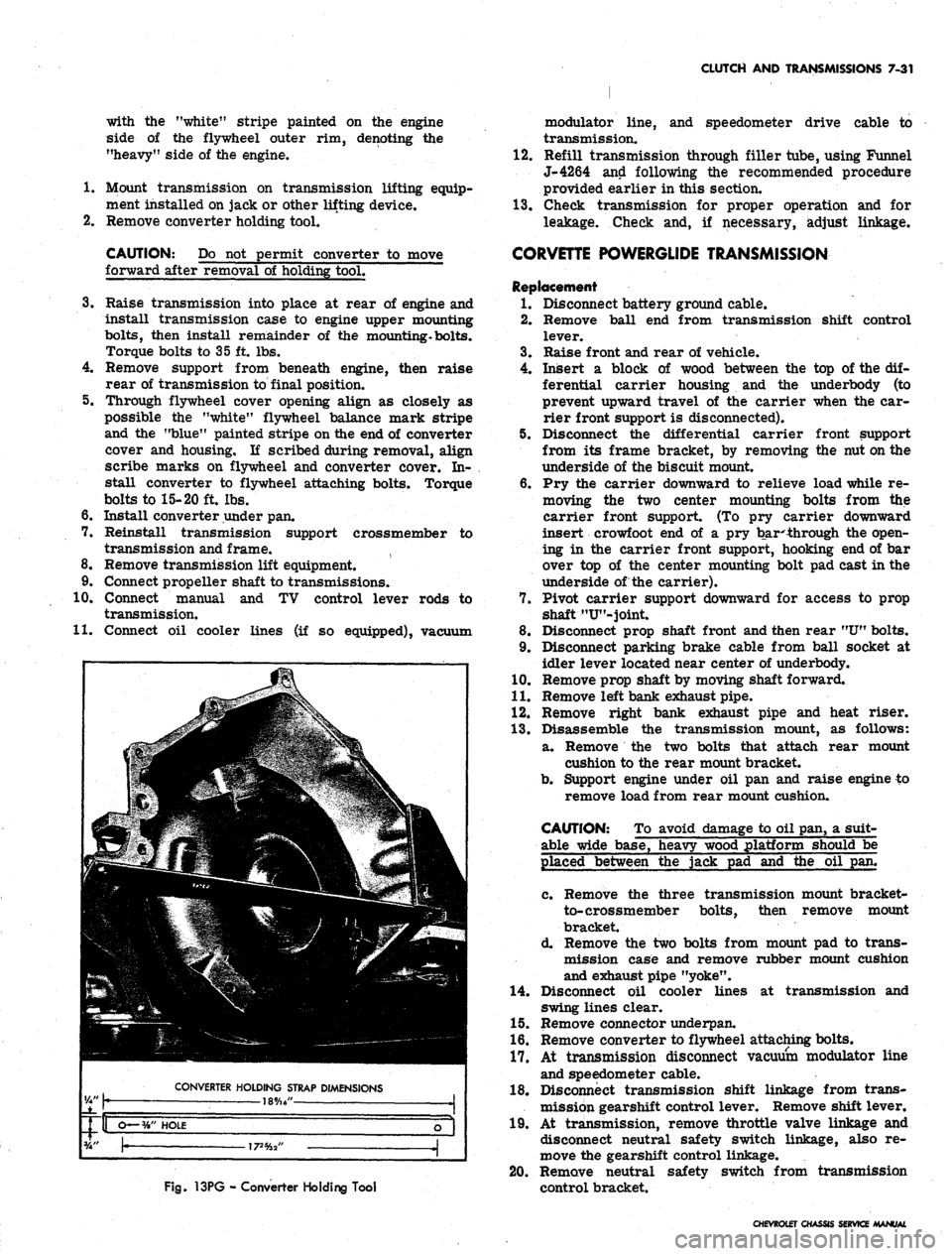
CLUTCH AND TRANSMISSIONS 7-31
with the "white" stripe painted on the engine
side of the flywheel outer rim, denoting the
"heavy" side of the engine.
1.
Mount transmission on transmission lifting equip-
ment installed on jack or other lifting device.
2.
Remove converter holding tool.
CAUTION: Do not permit converter to move
forward after removal of holding tool.
3.
Raise transmission into place at rear of engine and
install transmission case to engine upper mounting
bolts,
then install remainder of the mounting*bolts.
Torque bolts to 35 ft. lbs.
4.
Remove support from beneath engine, then raise
rear of transmission to final position.
5. Through flywheel cover opening align as closely as
possible the "white" flywheel balance mark stripe
and the "blue" painted stripe on the end of converter
cover and housing. If scribed during removal, align
scribe marks on flywheel and converter cover. In-
stall converter to flywheel attaching bolts. Torque
bolts to 15-20 ft. lbs.
6. Install converter under pan.
7. Reinstall transmission support crossmember to
transmission and frame.
8. Remove transmission lift equipment.
9. Connect propeller shaft to transmissions.
10.
Connect manual and TV control lever rods to
transmission.
11.
Connect oil cooler lines (if so equipped), vacuum
Fig.
13PG - Converter Holding Tool
modulato:* line, and speedometer drive cable to
transmission.
12.
Refill transmission through filler tube, using Funnel
J-4264 and following the recommended procedure
provided earlier in this section.
13.
Check transmission for proper operation and for
leakage. Check and, if necessary, adjust linkage.
CORVETTE POWERGLIDE TRANSMISSION
Replacement
1.
Disconnect battery ground cable.
2.
Remove ball end from transmission shift control
lever.
3.
Raise front and rear of vehicle.
4.
Insert a block of wood between the top of the dif-
ferential carrier housing and the underbody (to
prevent upward travel of the carrier when the car-
rier front support is disconnected).
5. Disconnect the differential carrier front support
from its frame bracket, by removing the nut on the
underside of the biscuit mount.
6. Pry the carrier downward to relieve load while re-
moving the two center mounting bolts from the
carrier front support. (To pry carrier downward
insert crowfoot end of a pry bar**hrough the open-
ing in the carrier front support, hooking end of bar
over top of the center mounting bolt pad cast in the
underside of the carrier).
7. Pivot carrier support downward for access to prop
shaft "U"-joint.
8. Disconnect prop shaft front and then rear
"U"
bolts.
9. Disconnect parking brake cable from ball socket at
idler lever located near center of underbody.
10.
Remove prop shaft by moving shaft forward.
11.
Remove left bank exhaust pipe.
12.
Remove right bank exhaust pipe and heat riser.
13.
Disassemble the transmission mount, as follows:
a. Remove the two bolts that attach rear mount
cushion to the rear mount bracket.
b.
Support engine under oil pan and raise engine to
remove load from rear mount cushion.
CAUTION: To avoid damage to oil pan, a suit-
able wide base, heavy wood platform should be
placed between the jack pad and the oil pan.
c. Remove the three transmission mount bracket-
to-crossmember bolts, then remove mount
bracket.
d. Remove the two bolts from mount pad to trans-
mission case and remove rubber mount cushion
and exhaust pipe "yoke".
14.
Disconnect oil cooler lines at transmission and
swing lines clear.
15.
Remove connector underpan.
16.
Remove converter to flywheel attaching bolts.
17.
At transmission disconnect vacuum modulator line
and speedometer cable.
18.
Disconnect transmission shift linkage from trans-
mission gearshift control lever. Remove shift lever.
19.
At transmission, remove throttle valve linkage and
disconnect neutral safety switch linkage, also re-
move the gearshift control linkage.
20.
Remove neutral safety switch from transmission
control bracket.
CHEVROLET CHASSIS SERVICE
Page 399 of 659
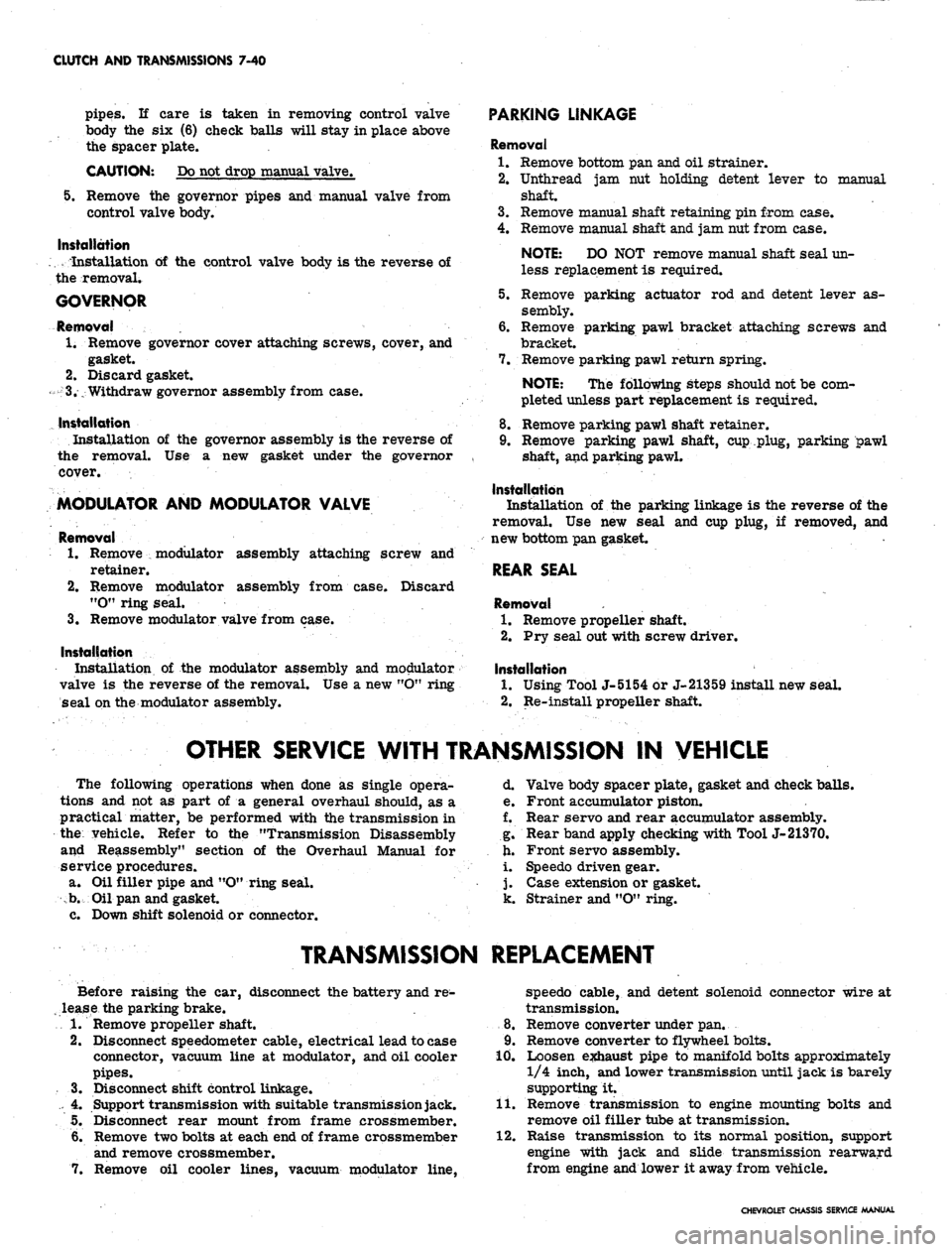
CLUTCH AND TRANSMISSIONS 7-40
pipes.
If
care
is
taken
in
removing control valve
body
the six (6)
check balls will stay
in
place above
the spacer plate.
CAUTION:
Do not
drop manual valve.
5. Remove
the
governor pipes
and
manual valve from
control valve body.
Installation
Installation
of the
control valve body
is the
reverse
of
the removal.
GOVERNOR
Removal
.
1.
Remove governor cover attaching screws, cover,
and
gasket.
2.
Discard gasket.
3.
Withdraw governor assembly from case.
Installation
Installation
of the
governor assembly
is the
reverse
of
the removal.
Use a new
gasket under
the
governor
cover.
MODULATOR AND MODULATOR VALVE
Removal
1.
Remove modulator assembly attaching screw
and
retainer.
2.
Remove modulator assembly from case. Discard
"O"
ring seal.
3.
Remove modulator valve from case.
Installation
Installation
of the
modulator assembly
and
modulator
valve
is the
reverse
of the
removal.
Use a new
"O" ring
seal
on the
modulator assembly.
PARKING LINKAGE
Removal
1.
Remove bottom
pan and oil
strainer.
2.
Unthread
jam nut
holding detent lever
to
manual
shaft.
3.
Remove manual shaft retaining
pin
from case.
4.
Remove manual shaft
and jam nut
from case.
NOTE:
DO NOT
remove manual shaft seal
un-
less replacement
is
required.
5. Remove parking actuator
rod and
detent lever
as-
sembly.
6. Remove parking pawl bracket attaching screws
and
bracket.
7. Remove parking pawl return spring.
NOTE:
The
following steps should
not be com-
pleted unless part replacement
is
required.
8. Remove parking pawl shaft retainer.
9.
Remove parking pawl shaft,
cup
plug, parking pawl
shaft, and parking pawl.
Installation
Installation
of the
parking linkage
is the
reverse
of the
removal.
Use new
seal
and cup
plug,
if
removed,
and
new bottom
pan
gasket.
REAR SEAL
Removal
1.
Remove propeller shaft.
2.
Pry
seal
out
with screw driver.
Installation
1.
Using Tool J-5154
or
J-21359 install
new
seal.
2.
Re-install propeller shaft.
OTHER SERVICE WITH TRANSMISSION IN VEHICLE
The following operations when done
as
single opera-
tions
and not as
part
of a
general overhaul should,
as a
practical matter,
be
performed with
the
transmission
in
the.
vehicle. Refer
to the
"Transmission Disassembly
and Reassembly" section
of the
Overhaul Manual
for
service procedures.
a. Oil
filler pipe
and
"O"
ring seal.
b.
Oil pan
and
gasket.
c. Down shift solenoid
or
connector.
d. Valve body spacer plate, gasket
and
check balls.
e. Front accumulator piston.
f.
Rear servo
and
rear accumulator assembly.
g.
Rear band apply checking with Tool J-21370.
Ji.
Front servo assembly.
i. Speedo driven gear.
j.
Case extension
or
gasket.
k.
Strainer
and
"O"
ring.
TRANSMISSION REPLACEMENT
Before raising
the car,
disconnect
the
battery
and re-
lease
the
parking brake.
1.
Remove propeller shaft.
8.
2.
Disconnect speedometer cable, electrical lead to case
9.
connector, vacuum line
at
modulator,
and oil
cooler
10.
pipes.
3.
Disconnect shift control linkage.
4.
Support transmission with suitable transmission jack.
11.
5. Disconnect rear mount from frame crossmember.
6. Remove
two
bolts
at
each
end of
frame crossmember
12.
and remove crossmember.
7. Remove
oil
cooler lines, vacuum modulator line,
speedo cable,
and
detent solenoid connector wire
at
transmission.
Remove converter under
pan.
Remove converter
to
flywheel bolts.
Loosen exhaust pipe
to
manifold bolts approximately
1/4
inch,
and
lower transmission until jack
is
barely
supporting
it.
Remove transmission
to
engine mounting bolts
and
remove
oil
filler tube
at
transmission.
Raise transmission
to its
normal position, support
engine with jack
and
slide transmission rearward
from engine
and
lower
it
away from vehicle.
CHEVROLET CHASSIS SERVICE MANUAL
Page 424 of 659

FUEL TANK
AND
EXHAUST SYSTEMS
8-18
CORVETTE
FUEL TANK
INDEX
Page
General Description.
. 8-18
Service Operations
8-18
Fuel Tank
8-18
Gauge Sending Unit
8-20
Fuel Lines.
8-20
GENERAL DESCRIPTION
20 GALLON TANK
Fig.
21
—Corvette Fuel Tanks
The Corvette
is
equipped with
a
standard
20
gallon
(approx.) tank
or an RPO 36
gallon (approx.) fiberglass
tank
(fig. 21). The
tanks
are
installed
at the
very rear
of
the
vehicle, convenient
for
direct fuel filling into
the
tank.
The
tanks
are
held
in
place
by
two metal straps
at-
tached individually
to a
removable
gas
tank frame
sup-
port.
Two
guides
at the end of
the straps
are
adjustable
for securing
the
straps onto
the
tank support. The tank
support
is
secured
to the
frame rail with flat washers,
lockwashers, bolts
and
nuts.
The
tanks' rest
on six
felt
anti-squeak pads.
One pad
centers
on the
rear frame
crossmember
and one at
each side
on the
same cross-
member.
At the
same rear location two pads
are
placed
on
the
tank
at the
metal support strap (rear) attachment
location
and
another anti-squeak
pad
cemented
on the
support
at
the front
of
the tank.
The fuel tanks
are
equipped with
a gas
gauge metering
unit,
a
fuel pickup, fuel strainer
and
vent line.
If it be-
comes necessary,
the
tank
can be
completely drained
by
removing
the
fuel pickup hose which
is
located
at
the
bot-
tom
of the
tank,
or
by removing the metering
for
quicker
draining.
A pressure vacuum type, positive vented design
cap,
conforming
to
I.C.C. regulations,
is
used on both regular
production
and
optional fuel tanks.
The cap is
inter-
changeable with past model tanks
for
service replace-
ment purposes.
SERVICE OPERATIONS
FUEL TANK
CAUTION:
IF THE GAS
TANK SHOULD
BE
REMOVED
AND
INSTALLED, CARE SHOULD
BE EXERCISED
TO
AVOID PUNCTURING,
DROPPING
OR
DENTING
THE GAS
TANK.
Removal
(20
Gallon Tank)
WARNING: FIRST REMOVE BATTERY
CABLE.
1.
Remove
the
spare tire from tire carrier.
2.
Remove spare tire carrier bolted attachments
and
carrier
(fig. 22).
3.
Remove
the "U"
bolt attachments
at
both rear tail
pipe
(See
Figure
23).
4.
Separate
the
exhaust system
at
the transmission sup-
port crossmember
by
loosening
the "U"
bolt nuts.
5. Remove both rear muffler brackets from
the
frame
and slide
the
muffler system rearward.
CHEVROLET CHASSIS SERVICE MANUAL